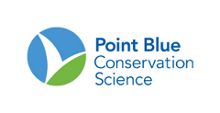Disclaimer Statement: The data map should be used for exploratory purposes only. Point Blue Conservation Science and its partners are not responsible and shall not be held liable for any use of these data. Complete data sets for rigorous scientific analyses are available upon request.
About the Maps – Suggested Reading Prior to Use
The data map summarizes shorebird and raptor observations recorded as part of the Migratory Shorebird Project, the Pacific Flyway Shorebird Survey, the British Columbia Coastal Waterbird Survey, the Peru Shorebird Atlas and the Chile Shorebird Atlas.
Scaled circles in the map indicate the average number of birds counted at that the sampling unit across all surveys without accounting for variation in the size of sampling units. These data summaries should not be considered a rigorous assessment, but rather general indicators of abundance and distribution of individual species and taxa. Only shorebirds and raptors are always recorded across all survey locations, so data from other taxa should be considered incomplete.
Data are collected using protocols that generally represent area searches. Survey protocols are available here and there are important differences between coastal and interior survey design. At coastal sites, surveys cover relatively large sampling units using coordinated counts during a short, standardized time period with certain tidal conditions, whereas at interior sites more numerous and considerably smaller individual sampling units are surveyed along predetermined routes. Most data used in the map were recorded during winter (November – February), and winter data are presented separately from data recorded during migration (March – May and July - October) which are recorded at far fewer sites.
All data used in the map are stored in the California Avian Data Center, which is a node of the Avian Knowledge Network that is managed by Point Blue Conservation Science. These data are compiled with assistance from over 100 partner organizations and nearly 500 volunteer citizen scientists each year.
Partial List of contributing Partner Organizations
Canada
Simon Fraser University
Bird Studies Canada
Canadian Wildlife Service
United States
David and Lucile Packard Foundation
US Forest Service
Environment for the Americas
US Fish and Wildlife Service
USGS
Manomet Center for Conservation Sciences
National Audubon Society
US Navy
US Army Core of Engineers
Elkhorn Slough Foundation
Humboldt State University
Sea and Sage Audubon
Audubon California
Morro Coast Audubon Society
Ecostudies Institute
Pilchuck Audubon
Whidbey Audubon
North Cascades Audubon
Skagit Audubon
Bolsa Chica Conservancy
Bodega Marina Lab
Elkhorn Slough Foundation
California Department of Fish and Wildlife
Grassland Water District
Cypress Grove Preserve - Audubon Canyon Ranch
San Francisco Bay Bird Observatory
Washington Department of Fish and Wildlife
Oregon Department of Fish and Wildlife
Klamath Bird Observatory
Los Angeles Natural History Museum
San Diego Zoo
Western Hemisphere Shorebird Reserve Network
Mexico
Universidad Nacional Autónoma de México (UNAM)Centro de Investigación Científica y de Educación Superior de Ensenada (CICESE)
Grupo Aves del Noroeste (GANO)
Terra Peninsular, A.C.
Honduras
Asociación Hondureña de Ornitología
Nicaragua
Fauna y Flora Internacional
Quetzalli
Costa Rica
Unión de Ornitólogos de Costa Rica
El Salvador
SalvaNATURA
Panama
Panama Audubon Society
Columbia
Asociación Calidris
Concejo Comunitario Esfuerzo Pescador
Parque Nacional Natural Sanquianga
Ecuador
Aves y Conservación
Peru
Servicio Nacional de Áreas Protegidas por el Estado (SERNANP)
Reserva Nacional de Paracas
Centro Neotropical de Entrenamiento en Humelales Peru (CNEH)
Naturaleza y Cultura Internacional
CORBIDI
Chile
Red de Observadores de Chile (ROC)
